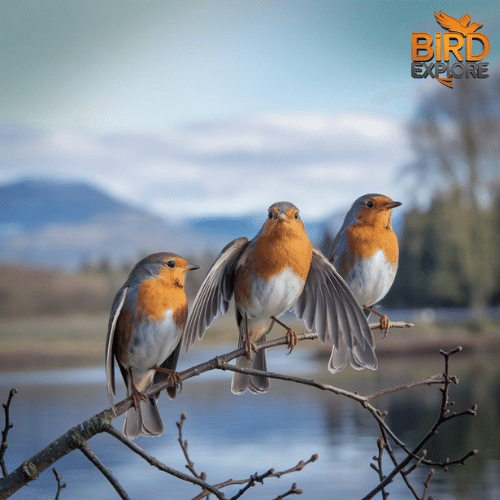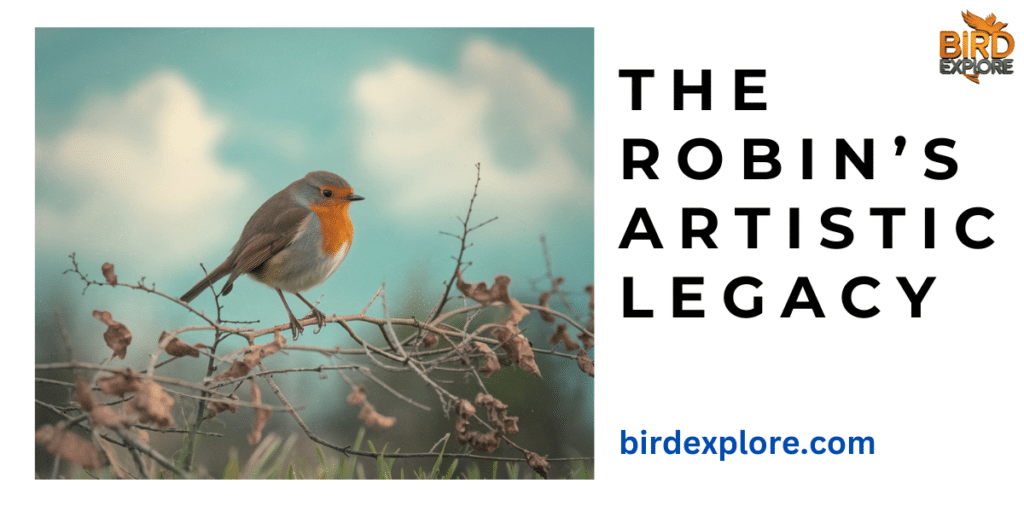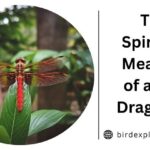In backyards and forests across North America, a flash of red catches the eye. The Red Robin Bird, known for its bright chest and joyful melody, represents much more than simply the arrival of spring. This beloved creature carries a wealth of symbolism, spiritual significance, and cultural importance that spans centuries and continents. Let’s embark on a journey to uncover the deep-rooted meaning behind this feathered friend and explore why it continues to captivate our hearts and minds.
Meet the Red-Breasted Charmer
Before diving into symbolism, let’s get acquainted with our subject. The American Robin (Turdus migratorius) is a member of the thrush family, known for its:
- Bright red-orange breast
- Gray-brown back and wings
- White eye ring
- Yellow bill
These birds typically measure 9-11 inches in length and have a wingspan of 12-16 inches. They’re a common sight in North American gardens, forests, and urban areas, adapting well to human presence.
A Year in the Life of Seasonal Behaviors
The Red Robin’s life cycle is closely tied to the changing seasons, contributing to its significance in folklore and spirituality:
- Spring: Robins return from southern wintering grounds, signaling renewal and rebirth.
- Summer: Breeding season begins, with females laying 3-5 blue eggs.
- Fall: Some robins migrate south, while others may stay if food is plentiful.
- Winter: Those that remain face hardships, symbolizing resilience and perseverance.
This annual cycle reinforces the Red Robin’s association with transformation and the cyclical nature of life.
Red Robins Historical Significance
The Red Robin has held an important place in human culture for hundreds of years, with its historical importance tied to many traditions and beliefs.

Ancient Tales
In Norse mythology, the robin was associated with Thor, the god of thunder. Legend has it that the bird got its red breast when it was scorched while stealing fire from the gods to bring warmth to humans.
From Pagan Beliefs to Christian Symbolism
As Christianity spread, the robin’s symbolism evolved. A popular tale tells of a robin that tried to remove the thorns from Jesus’ crown during the crucifixion, staining its breast red with Christ’s blood. This story transformed the robin into a symbol of compassion and selflessness in Christian tradition.
The Red Robin’s Role in Weather Folklore
Farmers and sailors have long looked to robins for weather predictions. Some common beliefs include:
- A robin singing in the open foretells fine weather
- Robins perching high in trees signal approaching storms
- If robins return early in spring, expect a good harvest
These beliefs highlight the Red Robin’s connection to nature’s cycles and its perceived role as a messenger between the natural and spiritual worlds.
Feathered Storyteller
The Red Robin’s spiritual significance extends across various cultures, each attributing unique meanings to this charismatic bird.
European Legends
In addition to the Christian legend, European folklore offers several explanations for the robin’s red breast:
- Celtic tradition: The robin flew too close to the sun, burning its chest.
- Welsh legend: The robin was pierced by an arrow while trying to free a captive.
- English tale: The robin burned itself while fanning flames to keep a dying human warm.
These stories consistently portray the robin as a symbol of sacrifice and compassion.
Native American Wisdom
Many Indigenous cultures perceive the Red Robin as a guardian entity and a symbol of rebirth and renewal. For example, the Iroquois see the robin as a sign of spring and new beginnings. Some communities view the appearance of a robin as a powerful signal to let go of the past and embrace new possibilities.
| Tribe | Robin Symbolism |
| Iroquois | Spring, new beginnings |
| Cherokee | Fertility, good fortune |
| Shoshone | Protector of children |
| Blackfoot | Peace, harmony |
Asian Perspectives: The Robin in Eastern Philosophies
While the American Robin isn’t native to Asia, similar red-breasted birds play roles in Eastern philosophies:
- In China, the bird with a red breast represents happiness and the arrival of spring.
- Japanese folklore associates red birds with the sun goddess Amaterasu, representing divine protection.
These cross-cultural interpretations highlight the universal appeal of the Red Robin’s symbolism and spiritual significance.
The Spiritual Essence of the Red Robin

At its core, the Red Robin embodies several key spiritual concepts that resonate across cultures and belief systems.
Harbinger of Spring
The robin’s return in spring has long been seen as a promise of new beginnings. This association with renewal and rebirth makes the Red Robin a powerful symbol of hope, particularly after periods of hardship or loss.
“Hope is the thing with feathers that perches in the soul.” – Emily Dickinson
While Dickinson wasn’t specifically referencing robins, her words capture the essence of what these birds represent to many: a tangible embodiment of hope.

The Robin as a Celestial Messenger
Many spiritual traditions view the Red Robin as a messenger between the earthly and spiritual realms. Its appearance is often interpreted as a sign from departed loved ones or a nudge from the universe to pay attention to important messages.
Courage in Small Packages and Lessons from Robin Behavior
Observing robin behavior can offer valuable spiritual lessons:
- Persistence: Robins tirelessly hunt for worms, teaching us the value of perseverance.
- Adaptability: Their ability to thrive in various environments reminds us to be flexible in the face of change.
- Nurturing: The devoted care robins show their young exemplifies selfless love and protection.
These traits contribute to the Red Robin’s role as a spiritual guide and source of inspiration.
When Robins Appear in Dreams
Dream interpretations involving robins can provide insight into our subconscious minds and spiritual journeys.

Common Dream Scenarios and Their Meanings
- A singing robin: May symbolize joy, good news, or a harmonious period in your life.
- A nesting robin: Could represent home, family, or the nurturing aspects of your personality.
- A robin in flight: Might indicate freedom, new opportunities, or spiritual growth.
- An injured or dead robin: Could signify loss, ended relationships, or the need to let go of something.
Cultural Variations in Robin Dream Symbolism
Different cultures may interpret robin dreams differently:
- Western interpretations often focus on renewal and hope.
- Native American traditions might see robin dreams as messages from spirit guides.
- In some Eastern cultures, dreaming of red birds like robins can be a sign of good fortune.
Remember, personal context and emotions play a significant role in dream interpretation. The appearance of a Red Robin in your dreams may hold unique significance based on your individual experiences and beliefs.
The Robin’s Artistic Legacy
The Red Robin has left an indelible mark on literature, art, and music, further cementing its cultural and spiritual significance.

Winged Muse
Numerous poets and authors have drawn inspiration from the robin:
- William Wordsworth’s poem “The Redbreast and the Butterfly” explores themes of nature and innocence.
- Emily Dickinson frequently referenced robins in her poetry, using them to symbolize hope and renewal.
- In Frances Hodgson Burnett’s “The Secret Garden,” the robin plays a pivotal role in guiding the protagonist to healing and growth.
Canvas Creatures
Artists have long been captivated by the Red Robin’s vibrant appearance and symbolic meaning:
- John James Audubon’s detailed illustrations in “Birds of America”
- Claude Monet’s painting “The Magpie” features a small red birds believed to be a robin.
- Contemporary wildlife artists like Robert Bateman, who capture the robin’s essence in stunning realism
These artistic depictions help perpetuate the robin’s symbolism and spiritual significance in popular culture.
Personal Encounters
Many people attach personal meaning to robin sightings, often interpreting them as signs or messages.
Timing is Everything: The Significance of When You See a Robin
- Early morning: A reminder to start your day with hope and positivity
- During difficult times: A sign of comfort and reassurance
- On important dates: Possibly a message from a departed loved one
Location, Location, Location:
The place where you encounter a Red Robin can influence its perceived message:
- In your garden: Might symbolize growth and nurturing in your personal life
- Near your workplace: Could signify career opportunities or professional growth
- On a journey: Might represent guidance or protection during transitions
Case Study
Sarah, a grief counselor, shared her experience:
“After my mother passed, I was struggling with the loss. One morning, as I sat on her favorite bench in the garden, a robin landed nearby. It stayed for several minutes, seeming to look right at me. I felt an overwhelming sense of peace and connection to my mother. Now, whenever I see a robin, I’m reminded of her love and the continuity of life.”
Sarah’s story illustrates how personal encounters with robins can provide comfort and reinforce their spiritual significance on an individual level.
Robin as a Spirit animals
In many spiritual traditions, the concept of spirit animals or totems plays a significant role. The Red Robin, as a totem, offers unique wisdom and lessons.

Characteristics Associated with the Robin Spirit
Those who resonate with the robin spirit may embody:
- Cheerfulness and optimism
- Nurturing and protective instincts
- Adaptability and resilience
- Strong connection to cyclical change and renewal
How to Connect with Your Robin Spirit Guide
To deepen your connection with the robin spirit:
- Spend time in nature, observing robins in their natural habitat
- Meditate on the robin’s qualities and how they relate to your life
- Keep a journal of robin sightings and any insights they bring
- Create or display artwork featuring robins to maintain a visual connection
Lessons and Growth Opportunities the Robin Spirit Offers
The robin spirit can guide you towards:
- Embracing new beginnings and opportunities
- Finding joy in simple pleasures
- Trusting your intuition and inner voice
- Balancing independence with community connection
By attuning to the robin’s energy, you may find yourself more aligned with nature’s rhythms and open to personal transformation.
Scientific Meets Spiritual
While exploring the Red Robin’s spiritual significance, it’s important to consider scientific perspectives that enhance our understanding of these remarkable birds.
The Robin’s Ecological Role
Robins play crucial roles in their ecosystems:
- Seed dispersal: By eating fruits and berries, robins help spread plant species
- Pest control: Their diet includes insects that can be harmful to gardens and crops
- Biodiversity indicators: Robin populations can reflect overall ecosystem health
Understanding these ecological contributions adds depth to our appreciation of the robin’s spiritual symbolism.
Cognitive Abilities of Robins
Recent studies have revealed fascinating insights into robin intelligence:
- Problem-solving skills: Robins can figure out complex feeding puzzles
- Social cognition: They show awareness of other birds’ intentions
- Magnetic sense: Robins can detect Earth’s magnetic field, aiding navigation
While these abilities don’t prove spiritual messaging capabilities, they demonstrate that robins are remarkably attuned to their environment in ways we’re still discovering.
Conservation Status
Currently, the American Robin is listed as a species of Least Concern by the IUCN. However, like many bird species, they face challenges from:
- Habitat loss due to urbanization
- Climate change affecting migration patterns
- Pesticide use impacting food sources
Conservation efforts are crucial to maintain healthy robin populations, allowing future generations to experience the joy and spiritual connection these birds bring.
Embracing the Robin’s Wisdom
As we conclude our exploration of the Red Robin’s symbolism and spiritual significance, consider how you might integrate its wisdom into your daily life.

Practical Ways to Honor the Robin’s Symbolism
- Create a robin-friendly garden with native plants and water sources
- Practice mindfulness by observing robins in nature
- Incorporate robin imagery or colors into your personal spaces
- Share robin stories and symbolism with others to spread positivity
Meditation and Reflection Practices Inspired by Red Robin Symbolism
Try this simple robin-inspired meditation:
- Find a quiet outdoor space where robins are often seen
- Close your eyes and take deep breaths, imagining the robin’s red breast
- Visualize yourself embodying the robin’s qualities: joy, resilience, and renewal
- Open your eyes and observe your surroundings with fresh perspective
This practice can help you connect with the robin’s energy and apply its lessons to your life.
Conclusion
The Red Robin, known for its colorful feathers and joyful song, has fascinated people for centuries. Its rich symbolism of renewal, hope, and transformation resonates across cultures and spiritual traditions. By blending cultural beliefs, personal experiences, and scientific understanding, we gain a fuller appreciation of this remarkable creature.
Whether you see the robin as a spiritual messenger, a harbinger of spring, or simply a beautiful part of nature, its presence offers a moment of connection and reflection. As you encounter Red Robins in your daily life, consider the depth of meaning they carry and the timeless wisdom they represent.
In a world of constant change, the robin reminds us of the cyclical nature of life, the promise of new beginnings, and the enduring spirit that connects us all. Let the Red Robin be your guide to renewal, your symbol of hope, and your inspiration for embracing the beauty and mystery of the natural world.

Kay Lovely is a dedicated writer for Bird Explore, where she brings the latest celebrity news and net worth updates to life. With a passion for pop culture and a keen eye for detail, Kay delivers engaging and insightful content that keeps readers informed about their favorite stars. Her extensive knowledge of the entertainment industry and commitment to accuracy make her a trusted voice in celebrity journalism.







